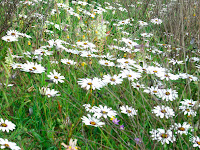I spotted yellow stripes and pinkish patches while driving along the R315 between Yzrefontain and Darling, in South Africa. I had had plenty of flowers during my fortnight stay in Cape Town and surroundings at the end of August two years ago, but, I realized slowing down, they are never enough. I was in the Swartland, the agricultural region some 50km north of Cape Town, where centuries of cultivations, especially wheat, have dramatically reduced the spontaneous vegetation, the renosterveld. The word, derived from the Afrikaans renoster, rhinoceros, refers to the widespread presence of these animals in this area in the past centuries, or recalls the similarity between the color of this animal’s hide and the dark hues of the evergreen low shrubs that constitute the main characteristic of this flora. Shrubs of the daisy family with small, grey-green leathery leaves dominate these fertile soils where trees are absent and beautiful bulbous plants thrive. The ephemeral flowers of irises, watsonia, gladiolus, babiana, ixia, moraea, geissorhiza and lilies follow each other along the seasons, tenacious and amazing, colouring areas that are often no more than small patches along the roads. Just recently, a new attention for the importance and beauty of the renosterveld has taken to the creation of reserves to protect this endangered flora. That afternoon, I was walking in one of them, the Tinie Versfeld Wildflower Reserve, near Darling. In 1958, Mr Marthinus Versfeld, the owner of this farm that dates back to 1830’s, donated around 20ha of his pristine land to the National Botanical Institute aware of the importance of conservation.
End of August means early spring in South Africa, and, step after step, I saw unknown beautiful flowers at my feet. No crocus, anemone, narcissi or primroses to celebrate the end of winter but …
End of August means early spring in South Africa, and, step after step, I saw unknown beautiful flowers at my feet. No crocus, anemone, narcissi or primroses to celebrate the end of winter but …
… large colonies of Lachenalia pallida, a low perennial with cylindrical
flowers, cream with brown markings, surrounded by extends of
white daisies, Dimorphotheca pluvialis.
Not far, the brilliant orange of the Gladiolus alatus attracted my attention with fragrant flowers whose greenish-yellow 3 lower tepals recall the wattles of a turkey.
The pink slender spikes of the Ixia scillaris stood out among a carpet of small yellow flowers.
Getting closer, I discovered little treasures, such as the Oxalis purpurea, with large pink flowers, or the Geissorhiza, whose small deep blue cups with a stunning red centre deceive the pollinators with their similarity with other flowers.
 Step after step the initial picture was fragmented in details, in single flowers to be discovered and identified in an endless, exciting game. In the distance, the presence of Zantedeschia aethiopica revealed damp soils and, I suspected, many other unknown flowers, but they were too far for my exploration.
Step after step the initial picture was fragmented in details, in single flowers to be discovered and identified in an endless, exciting game. In the distance, the presence of Zantedeschia aethiopica revealed damp soils and, I suspected, many other unknown flowers, but they were too far for my exploration.I left the reserve while another car stopped and a young couple came out. They looked around pointing at the spontaneous flowers with a smile.
Photos:
TravelinaGarden
Further reading:
Ruth Parker & Brita Lomba, Renosterveld a wilderness exposed, LR Publishers, 2009.
TravelinaGarden
Further reading:
Ruth Parker & Brita Lomba, Renosterveld a wilderness exposed, LR Publishers, 2009.
Links:
Info about the Tinie Versfeld Wildflower Reserve





